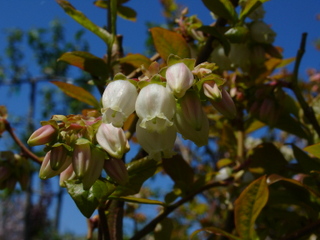
Backyard fruit and veggie gardening is a big trend in gardening these days. It’s a real treat to pick your own blueberries instead of buying them from the Stop and Shop at $5.00 a quart! They are easy to grow and delicious eaten right off of the bush, or with cream and sugar after dinner on a warm July night.
There are two basic types of blueberries, high bush (Vaccinium corymbosum) and low bush (Vaccinium angustifolium) (there are also half-high varieties, but lets not get into that right now). Low bush blueberries are the kind that I grew up calling “Wild Blueberries” in Nova Scotia. They grow along the ground forming a dense groundcover less than a foot high.
The fruit is small and flavorful, but somewhat of a hassle to harvest. I will never forget my first summer job hand-raking blueberries. My brother and I were bussed out to the country where the fields were all marked off into rows for picking. The blueberry rake looks much like an old fashioned cranberry rake. It’s a metal box with lots of tines close together on the bottom and a handle on top. The entire day is spent bent over scooping up berries and pouring them into buckets to be weighed. We were paid by the pound, but at the rate we picked, I’m not sure if we averaged any more than thirty dollars a day. I don’t quite remember how long it took for us to be fired, but I know it wasn’t longer than a week or two. Lets just say, I wouldn’t make a good itinerant fruit harvester.
High bush blueberries are more shrubby, growing up to six feet tall. They produce a crop of large berries held off the ground on the tips of the branches. Blueberry bushes are not self-fruitful. In order to get a good crop it is important to plant at least two different varieties close to each other. It’s also important to pay attention to when the cultivars flower – early, mid or late. In order to cross-pollinate, all the bushes must be in flower at the same time. Try not to plant only one early and one late variety, as they might not overlap flowering period.
Blueberries prefer consistently moist, fertile soil that is slightly acidic. In order to make them as happy as possible, amend the soil well at the time of planting, and consider using an acidifying fertilizer like Holly Tone if your soil is on the sweeter side. Always plant blueberries in full sun to maximize the amount of flower buds set and the proper ripening of the fruit. If your plants are happy they will fruit the first year, and bear a very good crop by the third year. Consider pruning the plants after the third or fourth year to keep new, productive canes coming up from the base of the plant. Check out YouTube for some great videos on Blueberry pruning http://youtu.be/fm6ZfpGy5oQ
I have compiled the following fact sheet with information on blueberries that are commonly available to us at Surfing Hydrangea to help our customers select the varieties that best suit their needs: Blueberry fact sheet
-Brad MacDonald
